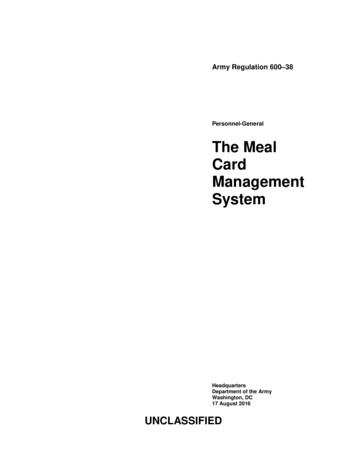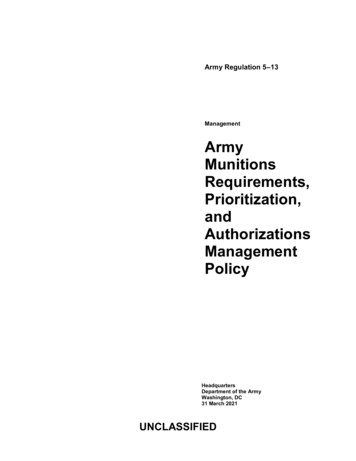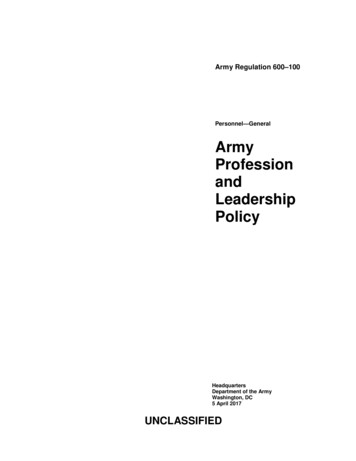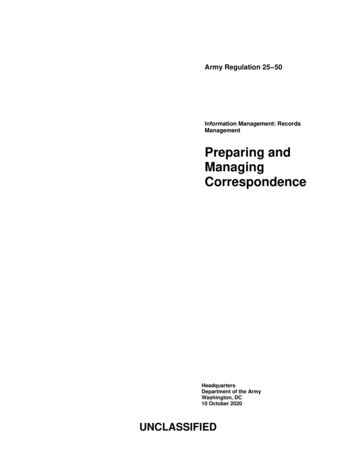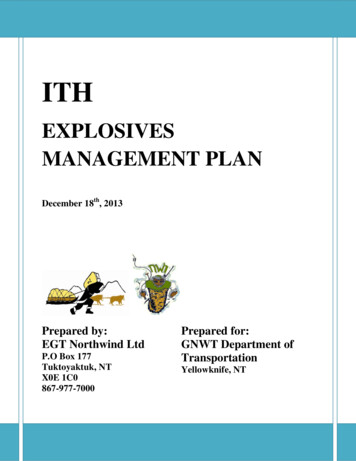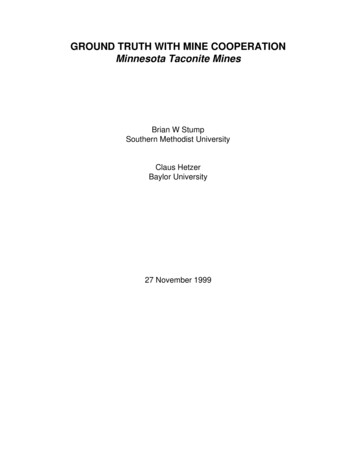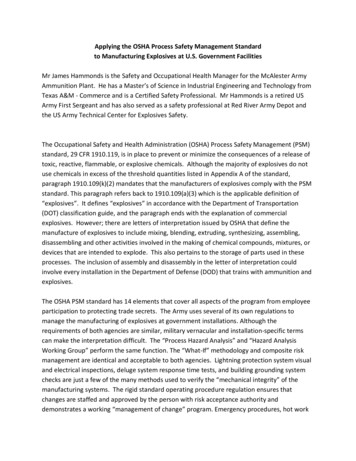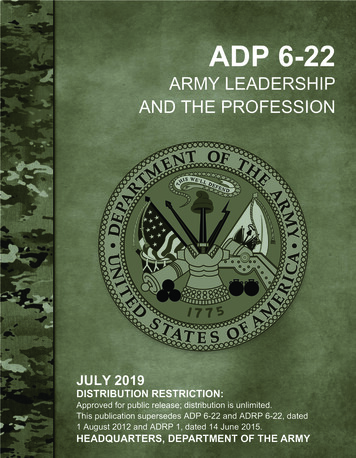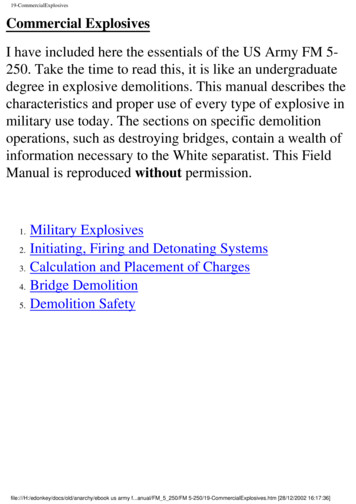
Transcription
19-CommercialExplosivesCommercial ExplosivesI have included here the essentials of the US Army FM 5250. Take the time to read this, it is like an undergraduatedegree in explosive demolitions. This manual describes thecharacteristics and proper use of every type of explosive inmilitary use today. The sections on specific demolitionoperations, such as destroying bridges, contain a wealth ofinformation necessary to the White separatist. This FieldManual is reproduced without permission.Military Explosives2. Initiating, Firing and Detonating Systems3. Calculation and Placement of Charges4. Bridge Demolition5. Demolition Safety1.file:///H:/edonkey/docs/old/anarchy/ebook us army f.anual/FM 5 250/FM 5-250/19-CommercialExplosives.htm [28/12/2002 16:17:36]
FM 5-250 - 1FM 5-250Chapter 1Military ExplosivesSection I. Demolition Materials1-1. Characteristics. To be suitable for use in militaryoperations, explosives must have certain properties. Militaryexplosives—- Should be inexpensive to manufacture and capable of beingproduced from readily available raw materials.- Must be relatively insensitive to shock or friction, yet be ableto positively detonate by easily prepared initiators.- Must be capable of shattering and must have the potentialenergy (high energy output per unit volume) adequate for thepurpose of demolitions.- Must be stable enough to retain usefulness for a reasonabletime when stored in temperatures between -80 and 165degrees Fahrenheit.- Should be composed of high-density materials (weight perunit volume).- Should be suitable for use underwater or in damp climates.- Should be minimally toxic when stored, handled, anddetonated.1-2. Selection of Explosives. Select explosives that fit thefile:///H:/edonkey/docs/old/anarchy/ebook us ar.olitions manual/FM 5 250/FM 5-250/FM5-250-1.htm (1 de 39) [28/12/2002 16:17:39]
FM 5-250 - 1particular purpose, based on their relative power. Consider allcharacteristics when selecting an explosive for a particulardemolition project.Table 1-1 contains significant information regarding many ofthe explosives described below.1-3. Domestic Explosives.a. Ammonium Nitrate. Ammonium nitrate is the least sensitiveof the military explosives. It requires a booster charge tosuccessfully initiate detonation. Because of its low sensitivity,ammonium nitrate is a component of many compositeexplosives (combined with a more sensitive explosive).Ammonium nitrate is not suitable for cutting or breachingcharges because it has a low detonating velocity. However,because of its excellent cratering affects and low cost,ammonium nitrate is a component of most cratering andditching charges. Commercial quarrying operations useammonium nitrate demolitions extensively. Pack ammoniumnitrate in an airtight container because it is extremelyhydroscopic (absorbs humidity). Ammonium nitrate orcomposite explosives containing ammonium nitrate are notsuitable for underwater use unless packed in waterproofcontainers or detonated immediately after placement.b. Pentaerythrite Tetranitrate (PETN). PETN is a highlysensitive and very powerful military explosive. Its explosivepotential is comparable to cyclonite (RDX) and nitroglycerin.Boosters, detonating cord, and some blasting caps containPETN. It is also used in composite explosives withtrinitrotoluene (TNT) or with nitrocellulose. A PETNfile:///H:/edonkey/docs/old/anarchy/ebook us ar.olitions manual/FM 5 250/FM 5-250/FM5-250-1.htm (2 de 39) [28/12/2002 16:17:39]
FM 5-250 - 1nitrocellulose composite (Ml 18 sheet explosive) is ademolition charge. The PETN explosive is a good underwaterdemolition because it is almost insoluble in water.1-1file:///H:/edonkey/docs/old/anarchy/ebook us ar.olitions manual/FM 5 250/FM 5-250/FM5-250-1.htm (3 de 39) [28/12/2002 16:17:39]
FM 5-250 - 1c. Cyclotrimethlenetrinitramine (RDX). RDX is also a highlysensitive and very powerful military explosive. It forms thebase charge in the M6 electric and M7 nonelectric blastingcaps.When RDX is desensitized, it serves as a subbooster,booster, bursting charge, or demolition charge.The principal use for RDX is in composite explosives, such asComposition A, B, and C explosives. RDX is availablecommercially under the name cyclonite.d. Trinitrotoluene. TNT is the most common military explosive.It maybe in composite form, such as a booster, a bursting, ora demolition charge, or in a noncomposite form. Since TNT isa standard explosive, it is used to rate other militaryexplosives.e. Tetryl. Tetryl is an effective booster charge in itsnoncomposite form and a bursting or a demolition charge incomposite forms. Tetryl is more sensitive and powerful thanTNT. However, RDX- and PETN-based explosives, whichhave increased power and shattering effects, are replacingtetryl and composite explosives containing tetryl.f. Nitroglycerin. Nitroglycerin is one of the most powerful highexplosives. Its explosive potential is comparable to RDX andPETN. Nitroglycerin is the explosive base for commercialdynamites. Nitroglycerine is highly sensitive and extremelytemperature-sensitive. Military explosives do not usefile:///H:/edonkey/docs/old/anarchy/ebook us ar.olitions manual/FM 5 250/FM 5-250/FM5-250-1.htm (4 de 39) [28/12/2002 16:17:39]
FM 5-250 - 1nitroglycerin because of its sensitivity. Do not use commercialdynamites in combat areas.g. Black Powder. Black powder is the oldest-known explosiveand propellant. It is a composite of potassium or sodiumnitrate, charcoal, and sulfur. Time fuses, some igniters, andsome detonators contain black powder.h. Amatol. Amatol is a mixture of ammonium nitrate and TNT.It is a substitute for TNT in bursting charges. Some olderbangalore torpedoes use 80-20 amatol (80 percentammonium nitrate and 20 percent TNT). Because amatolcontains ammonium nitrate, it is a hydroscopic compound.Keep any explosives containing amatol in airtight containers.If properly packaged, amatol remains viable for long periodsof time, with no change in sensitivity, power, or stability.i. Composition A3. Composition A3 is a composite explosivecontaining 91 percent RDX and 9 percent wax. The purposeof the wax is to coat, desensitize, and bind the RDX particles.Composition A3 is the booster charge in some newer shapedcharges and bangalore torpedoes. High-explosive plastic(HEP) projectiles may also contain Composition A3 as a maincharge.j. Composition B. Composition B is a composite explosivecontaining approximately 60 percent RDX, 39 percent TNT,and 1 percent wax. It is more sensitive than TNT. Because ofits shattering power and high rate of detonation, CompositionB is the main charge in shaped charges.k. Composition B4. Composition B4 contains 60 percent RDX,file:///H:/edonkey/docs/old/anarchy/ebook us ar.olitions manual/FM 5 250/FM 5-250/FM5-250-1.htm (5 de 39) [28/12/2002 16:17:39]
FM 5-250 - 139.5 percent TNT, and 0.5 percent calcium silicate.Composition B4 is the main charge in newer models ofbangalore torpedoes and shaped charges.l. Composition C4 (C4). C4 is a composite explosivecontaining 91 percent RDX and 9 percent nonexplosiveplasticizers. Burster charges are composed of C4. C4 iseffective in temperatures between -70 to 170 degreesFahrenheit; however, C4 loses its plasticity in the coldertemperatures.m. Tetrytol. Tetrytol is a composite explosive containing 75percent tetryl and 25 percent TNT. It is the explosivecomponent in demolition charges. Booster charges requiredifferent mixtures oftetryl and TNT. Tetrytol is more powerfulthan its individual components, is better at shatteringthanTNT, and is less sensitive than tetryl.n. Pentolite. Pentolite is a mixture of PETN and TNT. Becauseof its high power and detonating rate, a mixture of 50-50pentolite (50 percent PETN and 50 percent TNT) makes aneffective booster charge in certain models of shaped charges.o. Dynamites.(1) Standard Dynamite. Most dynamites, with the notableexception of military dynamite, contain nitroglycerin plusvarying combinations of absorbents, oxidizers, antacids, andfreezing-point depressants. Dynamites vary greatly in strengthand sensitivity depending on, among other factors, thepercentage of nitroglycerin they contain. Dynamites are forgeneral blasting and demolitions, including land clearing,file:///H:/edonkey/docs/old/anarchy/ebook us ar.olitions manual/FM 5 250/FM 5-250/FM5-250-1.htm (6 de 39) [28/12/2002 16:17:39]
FM 5-250 - 1cratering and ditching, and quarrying.(2) Military Dynamite. Military dynamite is a compositeexplosive that contains 75 percent RDX, 15 percent TNT, and10 percent desensitizers and plasticizers. Military dynamite isnot as powerful as commercial dynamite. Military dynamite’sequivalent strength is 60 percent of commercial dynamiters.Because military dynamite contains no nitroglycerin, it is morestable and safer to store and handle than commercialdynamite.1-4. Foreign Explosives.a. Composition. Foreign countries use a variety of explosives,including TNT, picric acid, amatol, and guncotton. Picric acidis similar to TNT, but it also corrodes metals and thus formsextremely sensitive compounds.WARNINGDo not use picric acid in rusted or corroded metal containers.Do not handle picric acid. Notify explosive ordnance disposal(EOD) personnel for disposition.b. Use. You may use the explosives of allied nations andthose captured from the enemy to supplement standardsupplies. Only expert demolitionists should use suchexplosives and then only according to instructions anddirectives of theater commanders. Captured bombs,propellants, and other devices may be used with US militaryexplosives for larger demolition projects, such as pier, bridge,tunnel, and airfield destruction. Most foreign explosive blocksfile:///H:/edonkey/docs/old/anarchy/ebook us ar.olitions manual/FM 5 250/FM 5-250/FM5-250-1.htm (7 de 39) [28/12/2002 16:17:39]
FM 5-250 - 1have cap wells large enough to receive US military blastingcaps. Since foreign explosives may differ from US explosivesin sensitivity and force, test shots should be made todetermine their adequacy before extensive use or mixing withUS-type explosives.Section II. Service Demolition Charges1-5. Block Demolition Charges. Block demolition charges areprepackaged, high-explosive charges for general demolitionoperations, such as cutting, breaching, and cratering. Theyare composed of the high-explosive TNT, tetrytol,Composition-C series, and ammonium nitrate.Block charges are rectangular inform except for the 40-pound,ammonium-nitrate block demolition charge, military dynamite,and the ¼-pound-TNT block demolition charge, which are allcylindrical in form. The various block charges available aredescribed in the text that follows.1-6. TNT Block Demolition Charge.a.Characteristics. TNT block demolitions are available inthree sizes (Table 1-2). The ¼-pound block is issued in afile:///H:/edonkey/docs/old/anarchy/ebook us ar.olitions manual/FM 5 250/FM 5-250/FM5-250-1.htm (8 de 39) [28/12/2002 16:17:39]
FM 5-250 - 1cylindrical, waterproof, olive-drab cardboard container.The ½-pound and l-pound blocks are available in similarrectangular containers. All of the three charges havemetal ends with a threaded cap well in one end.b. Use. TNT block demolition charges are effective for alltypes of demolition work. However, the ¼-pound charge isprimarily for training purposes.c. Advantages. TNT demolition charges have a highdetonating velocity. They are stable, relatively insensitive toshock or friction, and water resistant. They also areconveniently sized, shaped, and packaged.d. Limitations. TNT block demolition charges cannot bemolded and are difficult to use on irregularly shaped targets.TNT is not recommended for use in closed spaces becauseone of the products of explosion is poisonous gases.1-7. M112 Block Demolition Charge.a. Characteristics. The M112 block demolition charge consistsof 1.25 pounds of C4 packed in an olive-drab, Mylar-filmcontainer with a pressure-sensitive adhesive tape on onesurface (Figure1-2). The tape is protected by a peelable papercover. Table 1-2 (page 1-5) lists additional characteristics ofthe Ml12 block.file:///H:/edonkey/docs/old/anarchy/ebook us ar.olitions manual/FM 5 250/FM 5-250/FM5-250-1.htm (9 de 39) [28/12/2002 16:17:39]
FM 5-250 - 1b. Use. The M112 block demolition charge is used primarilyfor cutting and breaching. Because of its high cutting effectand its ability to be cut and shaped, the M1l2 charge is ideallysuited for cutting irregularly shaped targets such as steel. Theadhesive backing allows you to place the charge on anyrelatively flat, clean, dry surface with a temperature that isabove the freezing point. The Ml12 charge is the primaryblock demolition charge presently in use.WARNINGComposition C4 explosive is poisonous and dangerous ifchewed or ingested; its detonation or burning producespoisonous fumes. Cut all plastic explosives with a sharp steelknife on a nonsparking surface.Do not use shears.c. Advantages. You can cut to shape the M112 blockdemolition charge to fit irregularly shaped targets. The color ofthe wrapper helps camouflage the charge. Molding the chargewill decrease its cutting effect.d. Limitations. The adhesive tape will not adhere to wet, dirty,rusty, or frozen surfaces.1-8. M118 Block Demolition Charge.file:///H:/edonkey/docs/old/anarchy/ebook us ar.olitions manual/FM 5 250/FM 5-250/FM5-250-1.htm (10 de 39) [28/12/2002 16:17:39]
FM 5-250 - 1a.Characteristics. The M118 block demolition charge, orsheet explosive, is a block of four ½-pound sheets offlexible explosive packed in a plastic envelope (Figure 13). Twenty Ml18 charges and a package of 80 M8 blastingcap holders are packed in a wooden box. Each sheet ofthe explosive has a pressure-sensitive adhesive tapeattached to one surface. Table 1-2 (page 1 -5) listsadditional characteristics for the M118 charge.b. Use. The Ml18 charges are designed for cutting, especiallyagainst steel targets. The sheets of explosive are easily andquickly applied to irregular and curved surfaces and are easilycut to any desired dimension. The Ml18 charge is effective asa small breaching charge but, because of its high cost, it isnot suitable as a bulk explosive charge.c. Advantages. The flexibility and adhesive backing of thesheets allow application to a large variety of targets. You cancut the ½-pound sheets to any desired dimension and applythem in layers to achieve the desired thickness. The Ml18charge is not affected by water, making it acceptable forunderwater demolitions.d. Limitations. The adhesive tape will not adhere to wet, dirty,rusty, or frozen surfaces.file:///H:/edonkey/docs/old/anarchy/ebook us ar.olitions manual/FM 5 250/FM 5-250/FM5-250-1.htm (11 de 39) [28/12/2002 16:17:39]
FM 5-250 - 11-9. M186 Roll Demolition Charge.a. Characteristics. The Ml86 roll demolition charge, shown inFigure 1-4, is identical to the Ml18 block demolition chargeexcept that the sheet explosive is in roll form on a 50-foot,plastic spool. Each foot of the roll provides approximately ahalf pound of explosive. Included with each roll are 15 M8blasting cap holders and a canvas bag with carrying strap.Table 1-2 (page 1-5) lists additional characteristics for theM186 charge.b. Use. Use the M186 roll demolition charge in the samemanner as the Ml18 block demolition charge. The Ml86charge is adaptable for demolishing targets that require theuse of flexible explosives in lengths longer than 12 inches.c. Advantages. The Ml86 roll demolition charge has all theadvantages of the Ml18 block demolition charge. You can cutthe M186 charge to the exact lengths desired.d. Limitations. The adhesive backing will not adhere to wet,dirty, rusty, or frozen surfaces.Forty-Pound, Ammonium-Nitrate Block Demolition Chargefile:///H:/edonkey/docs/old/anarchy/ebook us ar.olitions manual/FM 5 250/FM 5-250/FM5-250-1.htm (12 de 39) [28/12/2002 16:17:39]
FM 5-250 - 1a.Characteristics. Figure 1-5 (page 1-8) shows the 40pound, ammonium-nitrate block demolition charge orcratering charge. It is a watertight, cylindrical metalcontainer with approximately 30 pounds of an ammoniumnitrate-based explosive and 10 pounds of TNT-basedexplosive booster in the center, next to the primingtunnels. The two priming tunnels are located to theoutside of the container, midway between the ends. Onetunnel serves as a cap well for priming the charge with anM6 electric or M7 nonelectric military blasting cap. Theother tunnel series as a priming path, with the detonatingcord passing through the tunnel and knotted at the end.There is a cleat between the tunnels to secure the timeblasting fuse, electrical firing wire, or detonating cord. There isa metal ring on the top of the container for lowering thecharge into its hole. Table 1-2 (page 1-5) lists additionalcharacteristics for the 40-pound, ammonium-nitrate blockdemolition charge.b. Use. This charge is suitable for cratering and ditchingoperations. Its primary use is as a cratering charge, but it alsofile:///H:/edonkey/docs/old/anarchy/ebook us ar.olitions manual/FM 5 250/FM 5-250/FM5-250-1.htm (13 de 39) [28/12/2002 16:17:39]
FM 5-250 - 1is effective for destroying buildings, fortifications, and bridgeabutments.c. Advantages. The size and shape of this charge make itideal for cratering operations. It is inexpensive to producecompared to other explosives.d. Limitations. Ammonium nitrate is hydroscopic. When wet, itwill not detonate. To ensure detonation, use metal containersshowing no evidence of water damage. Detonate all chargesplaced in wet or damp boreholes as soon as possible.1-11. Ml Military Dynamite.a. Characteristics. M1 military dynamite is an RDX-basedcomposite explosive containing no nitroglycerin (Figure 1-6).M 1 dynamite is packaged in ½-pound, paraffin-coated,cylindrical paper cartridges, which have a nominal diameter of1.25 inches and a nominal length of 8 inches.Table 1-2 (page 1-5) lists additional characteristics for Mlmilitary dynamite.b. Use. Ml dynamite’s primary uses are military book us ar.olitions manual/FM 5 250/FM 5-250/FM5-250-1.htm (14 de 39) [28/12/2002 16:17:39]
FM 5-250 - 1quarrying, ditching, and service demolition work. It is suitablefor underwater demolitions.c. Advantages. Ml dynamite will not freeze or perspire instorage. The Ml dynamite’s composition is not hydroscopic.Shipping containers do not require turning during storage. Mldynamite is safer to store, handle, and transport than 60percent commercial dynamite. Unless essential, do not usecivilian dynamite incombat areas.d. Limitations. Ml dynamite is reliable underwater only for 24hours. Because of its low sensitivity, pack sticks of militarydynamite well to ensure complete detonation of the charge. Mldynamite is not efficient as a cutting or breaching charge.Section III. Special Demolition Charges and Assemblies1-12. Shaped Demolition Charge. The shaped demolitioncharge used in military operations is a cylindrical block of highexplosive. It has a conical cavity in one end that directs thecone-lining material into a narrow jet to penetrate materials(Figure 1-7). This charge is not effective underwater, sinceany water in the conical cavity will prevent the high-velocity jetfrom forming. To obtain maximum effectiveness, place thecavity at the specified standoff distance from the target, anddetonate the charge from the exact rear center, using only thepriming well provided. Never dual prime a shaped charge.a. Characteristics.(1)Fifteen-Pound, M2A4 Shaped Demolition Charge. TheM2A4 charge contains a 0.1 l-pound (50 gram) booster ofComposition A3 and a 11.5-pound main charge offile:///H:/edonkey/docs/old/anarchy/ebook us ar.olitions manual/FM 5 250/FM 5-250/FM5-250-1.htm (15 de 39) [28/12/2002 16:17:39]
FM 5-250 - 1compositionB. It is packaged three charges per wooden box (total weightis 65 pounds). This charge has a moisture-resisting, moldedfiber container. A cylindrical fiber base slips onto the end ofthe charge to provide a 6-inch standoff distance. The cavityliner is a cone of glass. The charge is 14 5/16 inches highand 7 inches in diameter, including the standoff.(2) Forty-Pound, M3A1 Shaped Demolition Charge. TheM3A1 charge contains a 0.1 l-pound (50 gram) booster ofComposition A3 and a 29.5-pound main charge ofComposition B. It is packaged one charge per box (totalweight is 65 pounds). The charge is in a metal container. Thecone liner also is made of metal. A metal tripod provides a 15inch standoff distance. The charge is 15 ½ inches high and 9inches in diameter, not including standoff.file:///H:/edonkey/docs/old/anarchy/ebook us ar.olitions manual/FM 5 250/FM 5-250/FM5-250-1.htm (16 de 39) [28/12/2002 16:17:39]
FM 5-250 - 1b. Use. A shaped demolition charge’s primary use is forboring holes in earth, metal, masonry,concrete, and pavedand unpaved roads. Its effectiveness depends largely on itsshape, composition, and placement. Table 1-3, lists thepenetrating capabilities of various materials and the properstandoff distances for these charges.c. Special Precautions. To achieve the maximumfile:///H:/edonkey/docs/old/anarchy/ebook us ar.olitions manual/FM 5 250/FM 5-250/FM5-250-1.htm (17 de 39) [28/12/2002 16:17:39]
FM 5-250 - 1effectiveness of shaped charges—Center the charge over thetarget point. Align the axis of the charge with the direction ofthe desired hole. Use the pedestal to obtain the properstandoff distance.Suspend the charge at the proper height on pickets or tripods,if the pedestal does not provide the proper standoff distance.Remove any obstruction in the cavity liner or between thecharge and the target.1-13. M183 Demolition Charge Assembly.a. Characteristics. The Ml83 demolition charge assembly orsatchel charge consists of 16 M112 (C4) demolition blocksand 4 priming assemblies. It has a total explosive weight of 20pounds. The demolition blocks come in two bags, eight blocksper bag. The two bags come in an M85 canvas carrying case.Two M85 cases come in a wooden box 17 1/8 by 11½ by ok us ar.olitions manual/FM 5 250/FM 5-250/FM5-250-1.htm (18 de 39) [28/12/2002 16:17:39]
FM 5-250 - 1Each priming assembly consists of a 5-foot length ofdetonating cord with an RDX booster crimped to each endand a pair of Ml detonating-cord clips for attaching the primingassembly to a detonating cord ring or line main.b. Use. The M183 assembly is used primarily forereachingobstacles or demolishing structures when large demolitioncharges are required (Figure 1-8). The M183 charge also iseffective against smaller obstacles, such as small dragon’steeth.c. Detonation. Detonate the Ml83 demolition charge assemblywith a priming assembly and an electric or a nonelectricblasting cap or by using a detonating-cord ring main attachedby detonating cord clips.M1A2 Bangtlore-Torpedo Demolition Kit.a. Characteristics. Each kit consists of 10 loading ok us ar.olitions manual/FM 5 250/FM 5-250/FM5-250-1.htm (19 de 39) [28/12/2002 16:17:39]
FM 5-250 - 110 connecting sleeves, and 1 nose sleeve. The loadingassemblies, or torpedoes, are steel tubes 5 feet long and 21/8 inches in diameter, grooved, and capped at each end(Figure 1-9, page 1-12). The torpedoes have a 4-inch,Composition A3 booster (½ pound each) at both ends of each5-foot section. The main explosive charge is 10½ pounds ofComposition B4. The kit is packaged in a 60¾- by 13¾- by 49/16-inch wooden box and weighs 198 pounds.b. Use. The primary use of the torpedo is clearing pathsthrough wire obstacles and heavy undergrowth. It will clear a3- to 4-meter-wide path through wire obstacles.WARNINGThe Bangalore torpedo may detonate a live mine when beingplaced. To prevent detonation of the torpedo duringplacement, attach the nose sleeve to a fabricated dummysection (approximately the same dimensions as a singleBangalore section) and place the dummy section onto thefront end of the torpedo.c. Assembly. All sections of the torpedo have threaded capwells at each end. To assemble two or more sections, press anose sleeve onto one end of one tube, and then connectsuccessive tubes, using the connecting sleeves provided untilyou have the desired length. The connecting sleeves makerigid joints. The nose sleeve allows the user to push thetorpedo through entanglements and across the ground.d. Detonation. The recommended method to detonate thetorpedo is to prime the torpedo with eight wraps of k us ar.olitions manual/FM 5 250/FM 5-250/FM5-250-1.htm (20 de 39) [28/12/2002 16:17:39]
FM 5-250 - 1cord and attach two initiation systems for detonation. Anothermethod for priming the Bangalore torpedo is by inserting anelectric or a nonelectric blasting cap directly into the cap well.Do not move the torpedo after it has been prepared fordetonation. You may wrap the end with detonating cord priorto placing it, but do not attach the blasting caps until thetorpedo is in place.M180 Demolition Kit (Cratering).a. Characteristics. This kit consists of an M2A4 shapedcharge, a modified M57 electrical firing device, a warhead, arocket motor, a tripod, and a demolition circuit (Figure 1- 10).The shaped charge, firing device, and warhead arepermanently attached to the launch leg of the tripod. Therocket motor and the demolition circuit (packed in a woodenfile:///H:/edonkey/docs/old/anarchy/ebook us ar.olitions manual/FM 5 250/FM 5-250/FM5-250-1.htm (21 de 39) [28/12/2002 16:17:39]
FM 5-250 - 1subpack) are shipped separately. The kit weighsapproximately 165 pounds (74.25 kilograms). TM 9-1375-21312-1 provides the assembly procedures, operationaldescription, and maintenance instructions for the Ml80 kit.b. Use. The M180 is designed to produce a large crater incompacted soil or road surfaces, but not in reinforcedconcrete, arctic tundra, bedrock, or sandy soil. The chargeproduces a crater in two stages. The shaped charge blows apilot hole in the surface. Then, the rocket-propelled warheadenters the hole and detonates, enlarging the pilot hole. Up tofive kits can be set up close together and fired simultaneouslyto produce an exceptionally large crater. Up to 15 kits can bewidely spaced and freed simultaneously for airfield pocketing.WARNINGRegardless of the number of kits used, the minimum safedistances for the M180 cratering kit are 1,200 meters forunprotected personnel and 150 meters for personnel underoverhead cover.c. Detonation. When firing the M180, use the M34 50-capblasting machine.Section IV. Demolition Accessories1-16. Time Blasting Fuse. The time blasting fuse transmits adelayed spit of flame to a non-electric blasting cap. The delayallows the soldier to initiate a charge and get to a safedistance before the explosion. There are two types of fuses:the M700 time fuse and safety fuse. Although safety fuse isnot often employed, it is still k us ar.olitions manual/FM 5 250/FM 5-250/FM5-250-1.htm (22 de 39) [28/12/2002 16:17:39]
FM 5-250 - 1a. M700 Time Fuse. The M700 fuse is a dark green cord, 0.2inches in diameter, with aplastic cover (Figure 1-1 1). The M700 bums at anapproximate rate of 40 seconds per foot. However, test theburning rate as outlined in Chapter 2 (paragraph 2-lb(l), page2-2).Depending on the date of manufacture, the cover may besmooth or have single yellow bands around the outside at 12or 18-inch intervals and double yellow bands at 60- or 90-inchintervals. These bands accommodate hasty measuring. Theoutside covering becomes brittle and cracks easily in arctictemperatures. The M700 time fuse is packaged in 50-footcoils, two coils per package, five packages per sealedcontainer, and eight containers (4,000 feet) per wooden box(30 1/8 by 15 1/8 by 14 7/8 inches). The total package weighs94 pounds.b. Safety Fuse. Safety fuse consists of black powder tightlywrapped with several layers of fiber and waterproofingmaterial. The outside covering becomes brittle and crackseasily in arctic temperatures. The burning rate may vary forfile:///H:/edonkey/docs/old/anarchy/ebook us ar.olitions manual/FM 5 250/FM 5-250/FM5-250-1.htm (23 de 39) [28/12/2002 16:17:39]
FM 5-250 - 1the same or different rolls (30 to 45 seconds per foot) underdifferent atmospheric and climatic conditions. This fuse maybe any color, but orange is the most common (Figure 1-12).Test each roll in the area where the charge will be placed(paragraph 2-lb(l), page 2-2). Since safety fuse burnssignificantly faster underwater, test it underwater beforepreparing an underwater charge.Safety fuse is packaged in 50-foot coils, two coils perpackage, and 30 packages (3,000 feet) per wooden box (24¾by 15¾ by 12 ½ inches). The total package weighs 93.6pounds.Detonating Cord.a. Characteristics. The American, British, Canadian, andAustralian (ABCA) StandardizationProgram recognizes this Type 1 detonating cord as thestandard detonating cord. Detonating cord (Figure 1-13)consists of a core of high explosive (6.4 pounds of PETN per1,000 feet) wrapped in a reinforced and waterproof olive-drabplastic coating. This detonating cord is approximately 0.2inches in diameter, weighs approximately 18 pounds per1,000 feet, and has a breaking strength of 175 pounds.Detonating cord is functional in the same temperature rangeas plastic explosive, although the cover becomes brittle atlower temperatures. Moisture can penetrate the explosivefilling to a maximum distance of 6 inches from any cut orbreak in the coating. Water-soaked detonating cord willdetonate if there is a dry end to allow initiation. For thisreason, cut off and discard the first 6 inches of any new orfile:///H:/edonkey/docs/old/anarchy/ebook us ar.olitions manual/FM 5 250/FM 5-250/FM5-250-1.htm (24 de 39) [28/12/2002 16:17:39]
FM 5-250 - 1used detonating cord that nonelectric blasting caps arecrimped to. Also, leave a 6-inch overhang when maki
I have included here the essentials of the US Army FM 5-250. Take the time to read this, it is like an undergraduate degree in explosive demolitions. This manual describes the characteristics and proper use of every type of explosive in military use today. The sections on specific demolit


